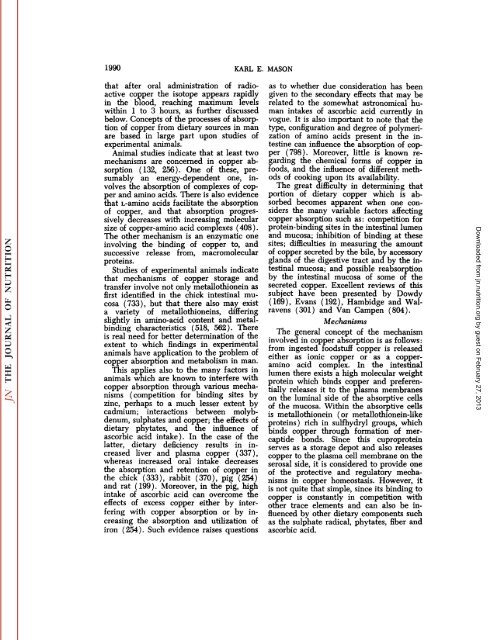conspectus of researchon copper metabolism and requirements
conspectus of researchon copper metabolism and requirements
conspectus of researchon copper metabolism and requirements
You also want an ePaper? Increase the reach of your titles
YUMPU automatically turns print PDFs into web optimized ePapers that Google loves.
1990 KARL E. MASON<br />
that after oral administration <strong>of</strong> radio<br />
active <strong>copper</strong> the isotope appears rapidly<br />
in the blood, reaching maximum levels<br />
within 1 to 3 hours, as further discussed<br />
below. Concepts <strong>of</strong> the processes <strong>of</strong> absorp<br />
tion <strong>of</strong> <strong>copper</strong> from dietary sources in man<br />
are based in large part upon studies <strong>of</strong><br />
experimental animals.<br />
Animal studies indicate that at least two<br />
mechanisms are concerned in <strong>copper</strong> ab<br />
sorption ( 132, 256 ). One <strong>of</strong> these, pre<br />
sumably an energy-dependent one, in<br />
volves the absorption <strong>of</strong> complexes <strong>of</strong> cop<br />
per <strong>and</strong> amino acids. There is also evidence<br />
that L-amino acids facilitate the absorption<br />
<strong>of</strong> <strong>copper</strong>, <strong>and</strong> that absorption progres<br />
sively decreases with increasing molecular<br />
size <strong>of</strong> <strong>copper</strong>-amino acid complexes (408 ).<br />
The other mechanism is an enzymatic one<br />
involving the binding <strong>of</strong> <strong>copper</strong> to, <strong>and</strong><br />
successive release from, macromolecular<br />
proteins.<br />
Studies <strong>of</strong> experimental animals indicate<br />
that mechanisms <strong>of</strong> <strong>copper</strong> storage <strong>and</strong><br />
transfer involve not only metallothionein as<br />
first identified in the chick intestinal mu<br />
cosa (733), but that there also may exist<br />
a variety <strong>of</strong> metallothioneins, differing<br />
slightly in amino-acid content <strong>and</strong> metalbinding<br />
characteristics (518, 562). There<br />
is real need for better determination <strong>of</strong> the<br />
extent to which findings in experimental<br />
animals have application to the problem <strong>of</strong><br />
<strong>copper</strong> absorption <strong>and</strong> <strong>metabolism</strong> in man.<br />
This applies also to the many factors in<br />
animals which are known to interfere with<br />
<strong>copper</strong> absorption through various mecha<br />
nisms (competition for binding sites by<br />
zinc, perhaps to a much lesser extent by<br />
cadmium; interactions between molyb<br />
denum, sulphates <strong>and</strong> <strong>copper</strong>; the effects <strong>of</strong><br />
dietary phytates, <strong>and</strong> the influence <strong>of</strong><br />
ascorbic acid intake). In the case <strong>of</strong> the<br />
latter, dietary deficiency results in in<br />
creased liver <strong>and</strong> plasma <strong>copper</strong> (337),<br />
whereas increased oral intake decreases<br />
the absorption <strong>and</strong> retention <strong>of</strong> <strong>copper</strong> in<br />
the chick (333), rabbit (370), pig (254)<br />
<strong>and</strong> rat (199). Moreover, in the pig, high<br />
intake <strong>of</strong> ascorbic acid can overcome the<br />
effects <strong>of</strong> excess <strong>copper</strong> either by inter<br />
fering with <strong>copper</strong> absorption or by in<br />
creasing the absorption <strong>and</strong> utilization <strong>of</strong><br />
iron (254). Such evidence raises questions<br />
as to whether due consideration has been<br />
given to the secondary effects that may be<br />
related to the somewhat astronomical hu<br />
man intakes <strong>of</strong> ascorbic acid currently in<br />
vogue. It is also important to note that the<br />
type, configuration <strong>and</strong> degree <strong>of</strong> polymeri<br />
zation <strong>of</strong> amino acids present in the in<br />
testine can influence the absorption <strong>of</strong> cop<br />
per (798). Moreover, little is known re<br />
garding the chemical forms <strong>of</strong> <strong>copper</strong> in<br />
foods, <strong>and</strong> the influence <strong>of</strong> different meth<br />
ods <strong>of</strong> cooking upon its availability.<br />
The great difficulty in determining that<br />
portion <strong>of</strong> dietary <strong>copper</strong> which is ab<br />
sorbed becomes apparent when one con<br />
siders the many variable factors affecting<br />
<strong>copper</strong> absorption such as: competition for<br />
protein-binding sites in the intestinal lumen<br />
<strong>and</strong> mucosa; inhibition <strong>of</strong> binding at these<br />
sites; difficulties in measuring the amount<br />
<strong>of</strong> <strong>copper</strong> secreted by the bile, by accessory<br />
gl<strong>and</strong>s <strong>of</strong> the digestive tract <strong>and</strong> by the in<br />
testinal mucosa; <strong>and</strong> possible reabsorption<br />
by the intestinal mucosa <strong>of</strong> some <strong>of</strong> the<br />
secreted <strong>copper</strong>. Excellent reviews <strong>of</strong> this<br />
subject have been presented by Dowdy<br />
(169), Evans (192), Hambidge <strong>and</strong> Wairavens<br />
(301) <strong>and</strong> Van Campen (804).<br />
Mechanisms<br />
The general concept <strong>of</strong> the mechanism<br />
involved in <strong>copper</strong> absorption is as follows:<br />
from ingested foodstuff <strong>copper</strong> is released<br />
either as ionic <strong>copper</strong> or as a <strong>copper</strong>amino<br />
acid complex. In the intestinal<br />
lumen there exists a high molecular weight<br />
protein which binds <strong>copper</strong> <strong>and</strong> preferen<br />
tially releases it to the plasma membranes<br />
on the luminal side <strong>of</strong> the absorptive cells<br />
<strong>of</strong> the mucosa. Within the absorptive cells<br />
is metallothionein (or metallothionein-like<br />
proteins) rich in sulfhydryl groups, which<br />
binds <strong>copper</strong> through formation <strong>of</strong> mercaptide<br />
bonds. Since this cuproprotein<br />
serves as a storage depot <strong>and</strong> also releases<br />
<strong>copper</strong> to the plasma cell membrane on the<br />
serosal side, it is considered to provide one<br />
<strong>of</strong> the protective <strong>and</strong> regulatory mecha<br />
nisms in <strong>copper</strong> homeostasis. However, it<br />
is not quite that simple, since its binding to<br />
<strong>copper</strong> is constantly in competition with<br />
other trace elements <strong>and</strong> can also be in<br />
fluenced by other dietary components such<br />
as the sulphate radical, phytates, fiber <strong>and</strong><br />
ascorbic acid.<br />
Downloaded from<br />
jn.nutrition.org<br />
by guest on February 27, 2013
















